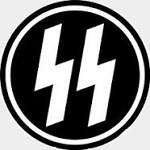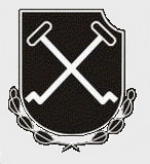FebrArmor Collection WW20201 German Late Production Sd. Kfz. 181 PzKpfw VI Tiger I Ausf. E Heavy Tank - SS-Hauptsturmfuhrer Michael Wittmann, "White 007", schwere SS Panzerabteilung 101, Cintheaux, France, August 1944 (1:72 Scale)
"I swear to thee, Adolf Hitler, as fuhrer and chancellor of the German Reich, loyalty and bravery. I vow to thee, obedience unto death."
- Oath sworn by Michael Wittmann upon joining the Schutzstaffel (SS), October 1936
 The German Waffenamt issued an order to design the VK4501(H) (as the PzKpfw VI Ausf. E was then known) in May 1941, just one month prior to the commencement of Operation Barbarossa. Interestingly, Henschel und Sohn of Kassel was charged with building the heavily armored chassis while Krupp, by far the largest munitionwerks in Germany, was given the task of developing the turret. The PzKpfw VI Ausfuhrung E (type E) was one of the first German tanks to feature a torsion bar with eight interleaved wheels, which was designed to support the weight of the mammoth 57-ton tank. The Ausf. E mounted a huge 8.8cm KwK36 L/56 cannon and featured two MG34 machine guns for close support against enemy infantry. By war's end, 1,354 vehicles had been produced, some rolling off the Wegmann assembly line.
The German Waffenamt issued an order to design the VK4501(H) (as the PzKpfw VI Ausf. E was then known) in May 1941, just one month prior to the commencement of Operation Barbarossa. Interestingly, Henschel und Sohn of Kassel was charged with building the heavily armored chassis while Krupp, by far the largest munitionwerks in Germany, was given the task of developing the turret. The PzKpfw VI Ausfuhrung E (type E) was one of the first German tanks to feature a torsion bar with eight interleaved wheels, which was designed to support the weight of the mammoth 57-ton tank. The Ausf. E mounted a huge 8.8cm KwK36 L/56 cannon and featured two MG34 machine guns for close support against enemy infantry. By war's end, 1,354 vehicles had been produced, some rolling off the Wegmann assembly line.
The Tiger differed from earlier German tanks principally in its design philosophy. Its predecessors balanced mobility, armor and firepower and were sometimes outgunned by their opponents.
While heavy, this tank was not slower than the best of its opponents. However, at over 50 tonnes dead weight, the suspension, gearboxes, and other such items had clearly reached their design limits and breakdowns were frequent if regular maintenance was not undertaken.
Although the general design and layout were broadly similar to the previous medium tank, the Panzer IV, the Tiger weighed more than twice as much. This was due to its substantially thicker armor, the larger main gun, greater volume of fuel and ammunition storage, larger engine, and a more solidly built transmission and suspension.
This particular 1:72 scale resin replica of a late production Tiger I Ausf. E heavy tank was commanded by legendary panzer ace
SS-Hauptsturmfuhrer Michael Wittmann, who was attached to schwere SS Panzerabteilung 101, then deployed to Cintheaux, France, during August 1944. Pre-order! Ship Date: March 2025.
Dimensions:
Width: 2-1/4-inches
Length: 4-1/2-inches
Release Date: ?
 Historical Account: "Home on his Shield" - After being promoted to the rank of SS-Haupsturmfuhrer, legendary panzer ace Michael Wittmann was offered but refused a position as an instructor at an armored training school, instead returning to Normandy and his men on July 6th, 1944. His unit, schwere SS Pamzerabteilung 101 (sSSPzAbt. 101), took part in the Battle for Caen, which raged from July 3rd to the 10th. In August, Wittmann and his crew received a new Tiger Ausf. E tank, which was assigned the command identification number "007". Thereafter, Wittmann, along with the rest of sSSPzAbt. 101, was transferred to a region just outside Cintheaux, France. At the time, strong German forces attempted to recapture the crucial city of Caen, which had become completely destroyed by weeks of incessant fighting. On August 8th, 1944, a new battle raged near Cintheaux, which would later become Wittmann's final engagement.
Historical Account: "Home on his Shield" - After being promoted to the rank of SS-Haupsturmfuhrer, legendary panzer ace Michael Wittmann was offered but refused a position as an instructor at an armored training school, instead returning to Normandy and his men on July 6th, 1944. His unit, schwere SS Pamzerabteilung 101 (sSSPzAbt. 101), took part in the Battle for Caen, which raged from July 3rd to the 10th. In August, Wittmann and his crew received a new Tiger Ausf. E tank, which was assigned the command identification number "007". Thereafter, Wittmann, along with the rest of sSSPzAbt. 101, was transferred to a region just outside Cintheaux, France. At the time, strong German forces attempted to recapture the crucial city of Caen, which had become completely destroyed by weeks of incessant fighting. On August 8th, 1944, a new battle raged near Cintheaux, which would later become Wittmann's final engagement.
According to
SS-Hauptscharfuhrer Hoflinger commanding Tiger "213", whose tank was positioned in the same field as Wittmann's tank but towards the rear and to the right of Wittmann's mount, at 12:55 AM he saw Wittmann's tank explode as it sat near the road to Caen-Cintheaux, at Gaumesnil, apparently struck by a long-range tank round fired by a Sherman Firefly from the Northampton Yeomanry. Afterwards, Wittmann and his crew were laid to rest beside what was left of their burned out Tiger, sadly without any graveyard markings. The War's most famous tank ace had paid the ultimate price in blood and iron, a fate awaiting many more tankers in the months to come.






![German McDonnell F-4F Phantom II Fighter-Bomber - 37+03, Jagdgeschwader 71 "Richtofen", Germany, 2009 [Anniversary Scheme] (1:72 Scale)](http://cdn4.volusion.store/qh9e9-jdqv9/v/vspfiles/photos/HA19052-1.jpg?v-cache=1740197136)


